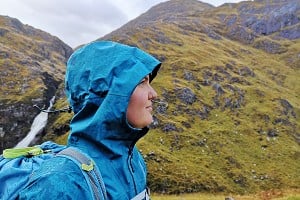
Top-end technical shells generally come at top-end prices. But if you don't require the ultimate in winter protection then you needn't spend so much. John McKenna trials a rather more affordable mountaineering shell, but one that still packs a punch in terms of breathability, fit and features: so how does he rate it?
Mammut's Taiss HS Hooded Jacket is a versatile, three-layer waterproof jacket made with Mammut Dry Expedition fabric. A substitute for the more expensive and ubiquitous Gore-Tex, this material is designed to be breathable, waterproof, and abrasion-resistant, making it ideal for mountaineering. Suitable for year-round use in the UK, the jacket's features and cut make it particularly well-suited for such activities. We tested the Taiss in Scotland over spring and early summer, using it for hillwalking and light mountaineering. So how does its performance stack up versus more popular, higher-priced fabrics?
In Use
The Taiss HS Hooded Jacket is designed for three-season mountaineering, and in my experience it's also great for all-round hillwalking in the UK. While its features and fit shine during mountaineering, I'm equally happy wearing it for hillwalking thanks to the excellent weatherproofing and breathability of Mammut's Dry Expedition fabric. The fit is perfect for layering, accommodating changes in conditions and activity levels throughout the day.
When mountaineering with a harness or pack hipbelt, the deep chest pockets, helmet-compatible hood, and articulated cut make it comfortable to wear. However, hillwalkers might miss having handwarmer pockets if using it in colder weather, for dog walking and the like.
When I've been scrambling or walking with just a t-shirt underneath, the fabric has felt really comfortable with a nice slightly forgiving stretch, compared to many stiffer and more crinkly shells. The downside is that durability takes a hit here, and I wouldn't recommend this for winter climbing or extensive rough rock use; for those activities, a tougher fabric would be preferable.
Overall, if you're looking for a versatile 3-season shell primarily for mountaineering, the Taiss HS Hooded Jacket is a great choice based on my experience. I'll touch upon the pros and cons in more depth in the following sections.
Fit
The Taiss HS comes in both men's and women's versions. The jacket is cut to Mammut's regular fit. I'm 6ft, relatively slim, and chose a size medium. This provides plenty of freedom of movement and works well with lightweight insulation layers. However, it's not roomy enough for easy layering over thick winter insulation, making it better suited for three-season use. The sleeve and body length are perfect, covering my wrists and just across my bum, with no tight or baggy areas. The jacket's articulation is excellent, with very little hem lift when I raise my arms, which is perfect when mountaineering or scrambling.
The hood can be used with or without a helmet and is sized well for both, with good freedom of movement in this area when you're looking above you climbing. The high collar and stiffened hood brim also offer good protection against the wind. Overall I'm really happy with the fit and can't fault the jacket in this department.
Fabric
Across the entire jacket Mammut have used their Dry Expedition 3-layer breathable fabric, a light 30 Denier polyamide.
This offers a 27,000mm hydrostatic head, making it excellently waterproof, and a breathability of 48,000 g/m²/24h, which on paper is very decent. How does this translate in real life? In my experience, when used up Scottish hills it's been completely waterproof in prolonged rain, and totally windproof. While breathability is hard to quantify as an end user, I've found moisture management excellent, and if I need extra ventilation, the large pit zips are helpful. The PFC-free DWR has also worked well and is still beading up nicely.
How does this compare to Gore-Tex? In my few months of use, I've noticed no real difference. However, there are trade-offs with this fabric, which I'll get to.
The light fabric is comfortable to wear and has a slight stretch, unlike heavier and more crinkly jackets. This makes it perfect for packing into a lighter summer pack and comfortable to wear and move in. On the home scales I make it 422g size M, which is very reasonable for this sort of midweight shell.
The main trade-off for the comfort, weatherproofing, and breathability of this jacket is its durability. While the 30D fabric is tough for its weight, there are limits; I anticipate needing to patch it if used extensively for climbing or mountaineering on rough rock. Day after day, the rough gabbro in the Cuillins might not be an ideal long-term environment for this jacket.
Features
This jacket provides everything you need: two deep chest pockets compatible with a climbing harness and backpack hipbelt. They're large enough to store a map and have water-repellent zippers that have kept my phone dry. There's also a low-bulk internal zippered pocket, perfect for a headtorch or car keys that you don't need to access frequently.
The hem drawcord is easy to use with gloves (as with all zipper pulls and drawcords) and is anti-snag, preventing me clipping my carabiners to them on my harness.
The two-way water-repellent underarm pit zips have been welcome for dumping heat and moisture on warmer days when hiking uphill in the rain. They're large, which I prefer in the summer.
A full-length two-way zip allow you to belay with this over a harness, with a storm flap running the full length and a soft fleece lining at the chin to prevent rubbing.
Ethics and Environment
Mammut are a member of FairWear. The fabric uses a PFC-free DWR.
Summary
Overall, I've been very happy with my experience with the Mammut Taiss HS Hooded Jacket. I was pleasantly surprised by how comfortable the fabric is while still providing the weatherproofing and breathability you'd expect from a midweight mountain shell. Some small trade-offs in durability mean I'll be a bit more careful when summer mountaineering on rough rock. Given its fair price in today's market where shells can cost twice this much, I'm satisfied with the jacket's great fit, good freedom of movement, well-sized hood, and well-executed features.















































Comments
£335 is not "less expensive" than any of the goretex I own!
There aren't too many jackets made of Gore Tex and probably none made of Gore Tex Pro for less than that are there (excluding sales)?
Yes, some Gore Tex Paclite jackets are cheaper but mountain jackets made of GTX Pro all seem to be around 500 quid now.
I've not tried this Mammut own brand material but they have a rep for making good mountain shells, if they can do that with a material that as John says seems the equal of GTX (particularly if he is comparing it with GTX PRO) but costing 2/3rds of the price, that sounds a good thing.
I got my current gtx pro jacket (berghaus) for around £170, that was 6 or 7 years ago now. Maybe I'm just out of touch with inflation, but on the other hand there was plenty of nonsense on the market back then for £400+ as well. Grumpy old man vibes either way :)
Worth a reminder that Gore-Tex is actually not such a good company, and their product is actually out of patent so competitors should be just as good.
https://www.youtube.com/watch?v=GGEzJJYiROk
Sounds like a good deal. Did you buy this at RRP? Bare in mind many people who end up purchasing a shell won't be paying the full RRP so this in combination with 6-7 years differences in prices (particularly in the last few years) might not seem so crazy. Premium shell jackets (particularly gore pro) across the board seem to becoming more and more expensive. There will always be an argument for what is 'worth it' or not and that will come down to personal choice at the end of the day. For me a top of the range shell will end up costing you quite a lot more for more marginal benefits at the upper end. Although if I'm wanting a jacket to really perform, last year after year and potentially save my life then I can't argue with someone who is wanting to pay these premiums. The Taiss for me certainly seems like you are getting much of the same premium benefits of a Gore Pro shell with a nice slice off the top range prices.